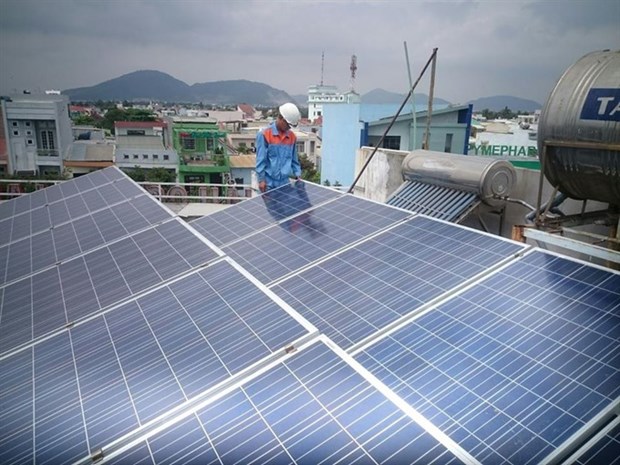Da Nang to develop nation’s first solar farm
The central city of Da Nang is set to build the first solar farm in the country that could connect to the national grid as early as the first quarter of 2018, project officials said.
 Solar power panels being installed on the roof of a house in Da Nang (Photo: VNA)
Solar power panels being installed on the roof of a house in Da Nang (Photo: VNA)Da Nang (VNA) - The central city of Da Nang is set to build the first solar farm in the country that could connect to the national grid as early as the first quarter of 2018, project officials said.
They said that the project is part of the city’s efforts to develop renewable energy and promote ‘green growth’ in the 2017-18 period.
The farm will be built on 6.7ha of the closed Khanh Son Landfill in Lien Chieu district at a cost of 112 billion VND (nearly 5 million USD). It will have a capacity of 4.4MWp (megawatts photovoltaic), helping reduce nearly 5,000 tonnes of carbon emissions each year.
According to the Bach Khoa Solar Power Investment and Development JSC, the project owner, the solar farm will supply 7.7 million kWh (kilowatt per hour) per year to the city’s power grid.
In April this year, Prime Minister Nguyen Xuan Phuc issued a decision on pricing that aims to encourage the development of solar power projects. The Decision 11/2017/QD-TTg, which took effect on June 1, 2017, says the output of solar power projects will be purchased for 2,086 VND (9.35 US cent) per kWh (excluding VAT), deemed a profitable rate for investors.
The price will be adjusted in line with the VND/USD exchange rate, and will only apply to power grid-connected projects with cell efficiency above 16 percent or productivity module of over 15 percent that are able to connect to the grid by June 2019.
Solar power project investors will be eligible for various other incentives, especially support related to land, investment capital and import and corporate income tax.
By the end of July 2017, hundreds of solar projects had been registered in Vietnam with total capacity of around 17,000 MW.
According to the Foreign Investment Agency under the Ministry of Planning and Investment, only 16 foreign-invested green energy projects were operating in Vietnam by the end of 2016, with a total registered capital of 778 million USD. Of these just 18 percent were investing in solar power.
In Da Nang, solar panels have been installed in some buildings, generating power for home consumption.
In 2011-15, the city cut 12,000 tonnes of carbon emissions and saved 433,000 USD by using nanotechnology in its public lighting system.
The city plans to support the installation of solar equipment at health centres and schools, and to fund research on solar technology and management.
Da Nang is said to have great renewable energy potential, with a 90km coastline, 2,000 hours of sunlight per year and an average wind speed of 3m per second.
According to a report prepared by the city’s Industry and Trade Department, around 30 percent of the city’s population use solar power for water heaters, while around 20 five-star hotels and resorts are using a solar power water heating system.-VNA













